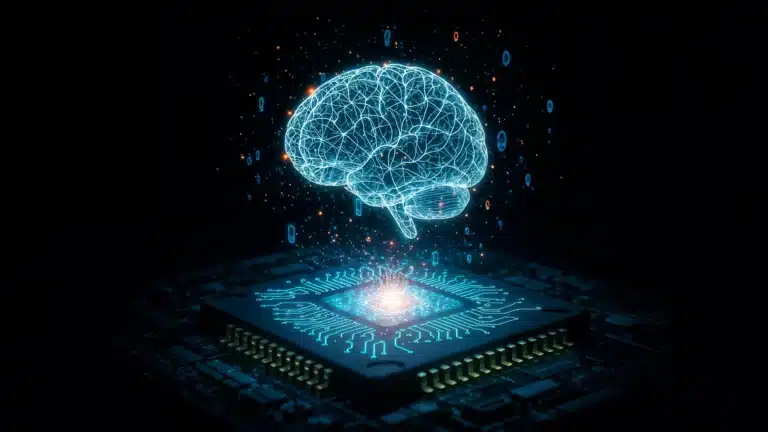Trending: Here are some Business Statistics and Trends to know

The ability to harness the power of data has become a cornerstone for innovation, competitive advantage, and informed decision-making. But what exactly is data science, and why has it emerged as one of the most transformative and sought-after fields across industries?
Data science uses data to find insights and guide decisions using statistics, computer science, and domain knowledge. It’s about analyzing complex datasets to gain valuable information. This multidisciplinary approach enables organizations to uncover hidden patterns, make accurate predictions, and drive strategic actions that shape the future.
This comprehensive guide will illuminate the essential concepts, tools, and trends that define what data science truly is and why it matters now more than ever.
This article will explain “what is data science,” how it works, and its importance.
Key Takeaways
- Data science integrates various disciplines to transform data into actionable insights for informed decision-making, encompassing stages like collection, cleaning, analysis, and visualization.
- The evolution of data science, marked by significant milestones such as the introduction of Hadoop and the formal recognition of ‘data scientist,’ highlights its growing relevance and demand across industries.
- Data science distinguishes itself from related fields like data analytics and business intelligence through its focus on predictive analytics, leveraging advanced techniques including machine learning for enhanced decision-making.
Defining Data Science
Data science focuses on using data for research and reporting to derive valuable insights for decision-making.
It aims to transform data into actionable knowledge that influences strategic decisions and optimizes operations. This transformation involves a rigorous process that integrates various disciplines, including mathematics, statistics, machine learning, and computer science.
Data science employs techniques such as data mining, statistical modeling, and machine learning to forecast results and uncover hidden patterns within the data. These techniques help in making predictions and providing insights to inform business strategies and operations.
The data science process encompasses stages like data collection, cleaning, analysis, and visualization, each playing a critical role in ensuring that the derived insights are both accurate and valuable in a data science project.
Expertise in specific domains allows data scientists to effectively reveal patterns and generate meaningful insights, making it an indispensable skill in the field.
As organizations increasingly rely on data for decision-making, the demand for skilled data scientists continues to surge. Their ability to uncover actionable insights is what drives the relevance and importance of data science across various industries.
The Evolution of Data Science
The journey of data science began in 1962 when John Tukey emphasized the importance of data analysis, marking the merger of statistical methods with computational methods.
This was a pivotal moment that set the stage for the evolution of data science as we know it today. In 1977, the establishment of the International Association for Statistical Computing (IASC) aimed to bridge traditional statistics with modern computing technologies, further advancing the field.
The term ‘data scientist’ gained popularity in 2008, thanks to contributions from DJ Patil and Jeff Hammerbacher. This marked a significant milestone, as the profession started to gain recognition and importance. By 2011, job postings for data scientists surged by an astonishing 15,000%, reflecting the growing demand for expertise in data analysis and big data.
A pivotal advancement came in 2006 with the introduction of Hadoop, which enabled efficient processing and storage of large datasets that traditional systems struggled with. These milestones highlight the rapid evolution of data science, driven by technological advancements and the increasing value of data-driven decision-making in various industries.
Key Components of Data Science
The data science process encompasses all aspects of data management, from collection to modeling to generating insights. It starts with data collection, which involves gathering information from various sources like databases and IoT devices. The collected data often needs cleaning to remove errors and transform it into a usable format.
Exploratory Data Analysis (EDA) is a crucial step that helps in discovering patterns and trends within the collected data. Visualizing data through charts and graphs helps data scientists effectively communicate insights, making data visualization an indispensable component of the process.
Data scientists also design methods for data storage, manipulation, and descriptive analysis, ensuring that data is accessible and usable through graph analysis.
These key components work together to enable data scientists to derive insights and extract meaningful insights from vast amounts of data during the data discovery process to extract knowledge. Understanding and leveraging these components enable organizations to make informed decisions that drive business success.
Data Science vs. Related Fields
Data science often overlaps with related fields such as data analytics, business intelligence, and machine learning. However, each has its distinct focus and methodology. Data science integrates computer science, statistics, and domain knowledge to analyze data and extract meaningful insights for decision-making.
Data analytics, on the other hand, focuses more on statistical analysis and routine reporting. The distinctions among related fields are:
- Business intelligence emphasizes descriptive insights from historical data.
- Data science leans towards predictive analytics.
- Machine learning, a subset of data science, is used for predictive modeling.
Data Science vs. Data Analytics
Data analytics is a subset of data science, primarily focusing on statistics, mathematics, and statistical analysis.
Business analytics is often utilized by data analysts and data analyst who provide regular reports through routine analysis, extracting insights from well-defined quantitative data sets. This role is vital for businesses needing constant monitoring and reporting of their data, including data summarization.
While data analysts work with well-defined datasets, data scientists handle a wider range of data types and develop new data processing methods. This broader scope allows data scientists to uncover deeper insights and develop predictive models that can forecast future trends and outcomes.
Data Science vs. Business Intelligence
Business intelligence primarily relies on historical data for decision-making, creating reports and dashboards to fulfill the informational needs of stakeholders. This approach provides descriptive insights that help organizations understand past performance and trends.
Data science, in contrast, uses data to determine predictive variables and make forecasts. Predictive analytics, a key component of data science, utilizes historical and current predictive data patterns to make future predictions, enabling organizations to make proactive decisions.
Data Science vs. Machine Learning
Machine learning algorithms are a subset of data science that focuses on building models to predict outcomes based on data analysis. These models are essential for predictive modeling, which is a core aspect of data science. Integrating machine learning enhances data scientists’ predictive capabilities and provides more accurate forecasts.
The integration of machine learning into data science enables more accurate predictive modeling and enhances decision-making processes. The synergy between data science and machine learning drives innovation and efficiency in data-driven decision-making.
Tools and Techniques in Data Science
Python is the leading programming language in data science, known for its extensive user base and community support. R is another popular language, specifically designed for statistical analysis and favored for its powerful data manipulation and visualization capabilities.
These languages, along with libraries like TensorFlow and PyTorch, are essential for developing machine learning models.
Data visualization tools like:
- Matplotlib
- Tableau
- D3.js enable data scientists to create compelling data visualizations that communicate insights effectively. These different data science tools are crucial for presenting data in a way that is easy to understand and actionable.
For big data processing, tools like Apache Spark and Hadoop are indispensable. Apache Spark is known for its ability to process large datasets efficiently through in-memory computing, while Apache Hadoop processes large volumes of data across clusters, making it suitable for big data applications.
Natural language processing (NLP) techniques are becoming increasingly important in data science. Tools like the Natural Language Toolkit (NLTK) are widely used for NLP tasks within programming knowledge in Python programming.
Additionally, cloud computing continues to enhance scalability and accessibility, allowing organizations to quickly adapt their data handling capabilities.
The Data Science Process
The process starts with identifying and collecting data from various data sources. This raw data often contains errors and inconsistencies, making data extraction and cleaning a crucial step to ensure that the data can be used to extract data and interpret data and is free from mistakes.
After cleaning the data, careful analysis is essential to ensure accuracy in the identified patterns. Common programming languages and frameworks used for creating predictive models include Python, R, and libraries like PyTorch and TensorFlow. These tools enable data scientists to discover unique patterns and build models that can predict outcomes based on the analyzed data.
The final step in the data science process is presenting findings to the organization. This involves explaining results clearly and concisely, ensuring stakeholders understand the insights and can make informed decisions.
Applications of Data Science
Data science helps organizations understand customer behavior and optimize operations. In healthcare, it improves patient diagnosis and treatment by analyzing large datasets and recognizing patterns in health data. In finance, it aids in credit scoring, allowing for more accurate assessment of a borrower’s risk.
A key application of data science in credit card transactions includes fraud detection based on transaction variables. In marketing, data-driven insights help companies segment customers effectively and tailor their messaging.
Manufacturers use data science for predictive maintenance, which helps reduce equipment downtime and maintenance costs. Additionally, data science applications in agriculture enhance supply chain efficiency, helping producers manage inventory and optimize routes.
AI integration in autonomous vehicles relies heavily on data science to enhance safety and navigation capabilities.
Roles in Data Science
Data scientists play a critical role in organizations by collecting, organizing, analyzing, and interpreting data to drive strategic decision-making. They create and utilize algorithms to analyze data and uncover patterns that inform business strategies. Essential skills for data scientists, other data related roles, and data science professionals include programming, statistical analysis, and data visualization.
Data analysts clean, analyze, and visualize data to provide actionable insights, acting as a bridge between data scientists and business analysts and business stakeholders. Data engineers focus on building data infrastructure, managing data flow, and creating data pipelines, which are vital for data accessibility in data engineering.
Machine learning engineers focus on developing algorithms for predictive modeling and computational tasks. Data product managers oversee the development and success of data-driven products, ensuring alignment with business goals. The demand for skilled professionals in data science roles is growing, offering numerous career opportunities.
How to Become a Data Scientist
A strong educational background in relevant fields such as computer science, mathematics, or statistics is crucial for aspiring data scientists. These fields provide the necessary background in programming, statistical analysis, and problem-solving skills essential for data science. Many individuals pursue certification programs, data science courses, and degree programs to gain the required knowledge and skills to become a successful data scientist.
Key recommendations for preparing for data science roles include:
- Engaging in hands-on projects and case studies to prepare for real-world challenges.
- Building a portfolio that showcases real-world problem-solving skills, which is vital for securing data related roles.
- Developing specialized skills, particularly in machine learning, to distinguish oneself from other professionals and meet industry demand.
Networking at industry events and engaging on platforms like LinkedIn can significantly aid in job search efforts. Certifications, such as those from the Data Science Council of America, can validate skills and enhance job prospects. By combining education, practical experience, and networking, individuals can successfully embark on a career in data science.
Benefits and Challenges of Data Science
Data science offers numerous benefits, including:
- Significant improvements in decision-making speed and organizational efficiency
- Integration of various fields to help organizations understand product performance and optimize delivery timing
- Use of machine learning methods to provide accurate forecasts and estimates necessary for data-driven decision-making
However, data science also faces several challenges:
- Data privacy poses a significant challenge, as insights derived from data can be misused to harm individuals or organizations.
- The cost associated with advanced data science tools can be high, requiring training and expertise to use them effectively.
- Data governance ensures compliance with privacy laws and ethical standards in data handling.
Data democratization initiatives are making analytics tools accessible to a broader range of decision-makers, improving organizational data insights. Addressing these challenges and leveraging the benefits helps organizations maximize the value of their data science initiatives.
Future Trends in Data Science
The field of data science is evolving rapidly with new technologies and methods fundamentally changing the way data is analyzed and utilized.
Agentic AI, capable of making autonomous decisions, is predicted to be integrated into one-third of enterprise applications by 2028. These advancements indicate a transformative shift in data science practices, emphasizing the importance of adapting to a continually changing technological landscape.
Neural networks are becoming increasingly sophisticated, leading to breakthroughs in various applications of artificial intelligence. As these technologies advance, the potential for data science to drive innovation and efficiency in numerous industries will only continue to grow.
Summary
In summary, data science is a dynamic and rapidly evolving field that integrates various disciplines to transform data into actionable insights. From its historical evolution to its key components, tools, and techniques, data science plays a crucial role in decision-making across industries.
Understanding the differences between data science and related fields, the roles within data science, and the benefits and challenges it presents, equips individuals and organizations to leverage data for strategic advantage.
As we look to the future, data science is set to continue driving innovation and efficiency, making it an indispensable field in our data-driven world.
Frequently Asked Questions
What is the primary goal of data science?
The primary goal of data science is to convert data into actionable insights that inform strategic decisions and enhance operational efficiency. This transformation is crucial for driving informed decision-making within organizations.
How does data science differ from data analytics?
Data science encompasses a wider range of activities, including predictive analytics and data operations, whereas data analytics is specifically concerned with statistical analysis and routine reporting. Thus, data analytics can be viewed as a component of the broader field of data science.
What are some common tools used in data science?
Data science commonly utilizes programming languages such as Python and R, machine learning libraries like TensorFlow, and data visualization tools including Matplotlib and Tableau. These tools are essential for effectively analyzing and presenting data.
What are the key components of the data science process?
The key components of the data science process are data collection, data cleaning, exploratory data analysis (EDA), data visualization, and presenting findings to stakeholders. Understanding these steps is crucial for effectively leveraging data to inform decision-making.
What are some future trends in data science?
Future trends in data science will prominently feature the integration of agentic AI and advancements in neural networks, underscoring the critical need for adaptation to evolving technologies and methodologies.


